Have you ever dreamt of exploring a place where nature flourishes in its most pristine form? Welcome to Cuc Phuong National Park, Vietnam’s first and largest national park. This is a paradise for nature enthusiasts and biodiversity lovers. Besides, the sanctuary is a haven for a myriad of plant and animal species, offering visitors a unique glimpse into Vietnam’s rich natural heritage.
Establishment of the Park

To begin with, Cuc Phuong National Park was established in 1962 by President Ho Chi Minh, making it the first national park in Vietnam. Spanning over 22,000 hectares, it is located in the Ninh Binh province and extends into Hoa Binh and Thanh Hoa provinces. In particular, this park was created to protect the diverse ecosystems and the myriad species that inhabit them. Today, it stands as a testament to Vietnam’s commitment to conservation.
Cultural Importance

The park isn’t just about nature, it’s a cultural treasure too. Indeed, home to the Muong and Thai ethnic groups, Cuc Phuong offers a glimpse into the traditional lifestyles and customs that have been preserved for generations. Moreover, these communities live harmoniously with nature, practising sustainable agriculture and maintaining their cultural heritage.
Flora of Cuc Phuong

Cuc Phuong boasts an incredible diversity of plant life, with over 2,000 plant species. For example, giant ancient trees, some over 1,000 years old, create a dense canopy, while a variety of ferns, orchids, and medicinal plants add to the park’s botanical richness. The forest is a vibrant tapestry of greenery, with seasonal blooms adding splashes of color throughout the year. For instance, the rare and endangered Chukrasia tabularis and Terminalia myriocarpa are found here, underscoring the park’s botanical significance.
Fauna of Cuc Phuong

Similarly, the fauna here is just as impressive as the flora. The park is home to a myriad of animal species. In other words, the diversity includes mammals, birds, reptiles, and amphibians. Each contributes to the park’s complex ecosystem and makes it a hotspot for wildlife enthusiasts.
Mammals

With 133 mammal species, including the endangered Delacour’s langur and the clouded leopard, Cuc Phuong is a mammal-watcher’s dream. Moreover, other notable mammals include the Asian black bear, the Asiatic brush-tailed porcupine, and the northern pig-tailed macaque. In addition, night safaris offer a chance to see nocturnal animals like civets and lorises.
Birds

Bird lovers, rejoice! The park is a haven for over 300 bird species. From the rare silver pheasant to the colorful racket-tailed treepie, birdwatching here is an unforgettable experience. The diversity includes the crested serpent eagle, the bar-bellied pitta, and the endangered red-collared woodpecker. Birdwatching tours, often led by experienced guides, can help visitors spot these avian treasures.
Reptiles and Amphibians

Cuc Phuong’s 122 species of reptiles and amphibians, such as the Vietnamese salamander and king cobra, highlight the park’s rich herpetofauna. The park also houses several turtle species, including the critically endangered Annam leaf turtle. These creatures thrive in the park’s diverse habitats, from dense forests to freshwater streams.
Trekking and Hiking

The park offers several trekking and hiking trails that cater to all fitness levels. Trails like the Ancient Tree Trail and the Prehistoric Man Cave Trail let you explore the park’s diverse landscapes. The challenging 16km-loop to Silver Cloud Peak rewards hikers with panoramic views of the surrounding mountains and valleys.
Wildlife Watching

With patience and a bit of luck, you can spot some of the park’s elusive wildlife. Guided tours increase your chances of seeing rare species in their natural habitats. Rangers and local guides, with their extensive knowledge, can lead you to the best spots for sightings.
Bird Watching

Birdwatching tours are particularly popular. Equipped with a pair of binoculars, you can catch sight of numerous rare and exotic birds flitting through the trees. The park’s varied habitats, from wetlands to forests, provide ideal conditions for birdwatching throughout the year.
Cave Exploration

Cuc Phuong is home to several fascinating caves, such as the Cave of Prehistoric Man and the Son Cung Cave. These caves offer a peek into the park’s geological history and ancient human habitation. The Cave of Prehistoric Man, in particular, is significant for its archeological finds, including ancient tools and human remains dating back thousands of years.
Conservation Efforts
Endangered Species Protection
Cuc Phuong plays a crucial role in the conservation of endangered species. The Endangered Primate Rescue Center within the park is dedicated to the rehabilitation and protection of endangered primates. This center is pivotal in rescuing, rehabilitating, and reintroducing primates into the wild, particularly those rescued from the illegal wildlife trade.
Research and Education
The park is a hub for scientific research and education. It collaborates with international organizations to conduct biodiversity research and promote conservation education. Educational programs and workshops are regularly conducted to raise awareness about the importance of conservation among local communities and visitors.
Visiting Cuc Phuong National Park
Best Time to Visit
The ideal time to visit Cuc Phuong is during the dry season, from December to April. The weather is pleasant, and wildlife is more active. However, each season offers its unique charms, with the wet season (May to November) bringing lush greenery and vibrant life to the park.
How to Get There
Cuc Phuong is accessible from Hanoi, approximately 120 km away. You can reach the park by bus, car, or motorbike. The journey takes about 2.5 to 3 hours. Buses to Ninh Binh or Thanh Hoa from Hanoi are frequent, with onward local transport available to the park entrance.
Accommodation Options
From rustic bungalows to comfortable guesthouses, the park offers various accommodation options. Staying within the park lets you fully immerse yourself in the natural surroundings. For those seeking more comfort, nearby Ninh Binh town provides additional lodging options ranging from budget hotels to luxury resorts.
Tips for Visitors
- Wear comfortable hiking shoes for exploring trails.
- Bring insect repellent to ward off bugs.
- Hire a local guide for a richer experience and better wildlife spotting opportunities.
- Respect wildlife and maintain a safe distance to avoid disturbing them.
- Carry a reusable water bottle to stay hydrated and reduce plastic waste.
- Pack a raincoat if visiting during the wet season as sudden showers are common.
- Be mindful of local customs and traditions when visiting ethnic communities.
Conclusion
In conclusion, Cuc Phuong National Park is more than just a protected area; it’s a living museum of natural and cultural heritage. Whether you’re a nature lover, a wildlife enthusiast, or an adventurous explorer, Cuc Phuong offers a unique experience that you’ll treasure forever. Its rich biodiversity, stunning landscapes, and cultural significance make it a must-visit destination in Vietnam.
If you’re interested in visiting Cuc Phuong National Park, be sure to book a tour with YESD Travel. We offer a variety of tours to suit all budgets and interests.
FAQs
1. What is the best way to explore Cuc Phuong National Park?
Hiring a local guide is highly recommended to make the most of your visit. They can provide insights and help you spot wildlife, ensuring a richer and more informative experience.
2. Can I visit Cuc Phuong National Park year-round?
Yes, but the dry season (December to April) is the best time for pleasant weather and active wildlife. The wet season also offers unique experiences with lush landscapes and fewer tourists.
3. Are there any entrance fees for Cuc Phuong National Park?
Yes, there is an entrance fee that contributes to the park’s maintenance and conservation efforts. The fee supports various conservation projects and ensures the park remains a sanctuary for its diverse species.
4. Is it safe to explore the caves in Cuc Phuong?
Yes, it is safe if you follow the guidelines and preferably explore with a guide. The guides are knowledgeable about the caves’ history and geological features, making your exploration both safe and educational.
5. What should I bring for a day trip to Cuc Phuong?
Comfortable hiking shoes, insect repellent, a reusable water bottle, a camera for capturing the stunning scenery and wildlife, and a light jacket or raincoat if visiting during the wet season.
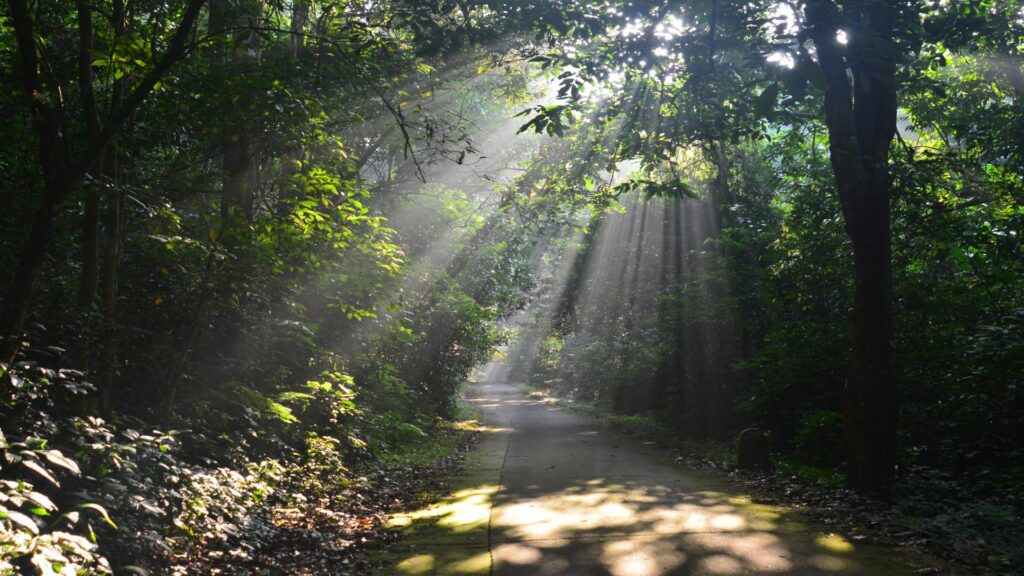 To begin with, Cuc Phuong National Park was established in 1962 by President Ho Chi Minh, making it the first national park in Vietnam. Spanning over 22,000 hectares, it is located in the Ninh Binh province and extends into Hoa Binh and Thanh Hoa provinces. In particular, this park was created to protect the diverse ecosystems and the myriad species that inhabit them. Today, it stands as a testament to Vietnam’s commitment to conservation.
To begin with, Cuc Phuong National Park was established in 1962 by President Ho Chi Minh, making it the first national park in Vietnam. Spanning over 22,000 hectares, it is located in the Ninh Binh province and extends into Hoa Binh and Thanh Hoa provinces. In particular, this park was created to protect the diverse ecosystems and the myriad species that inhabit them. Today, it stands as a testament to Vietnam’s commitment to conservation.
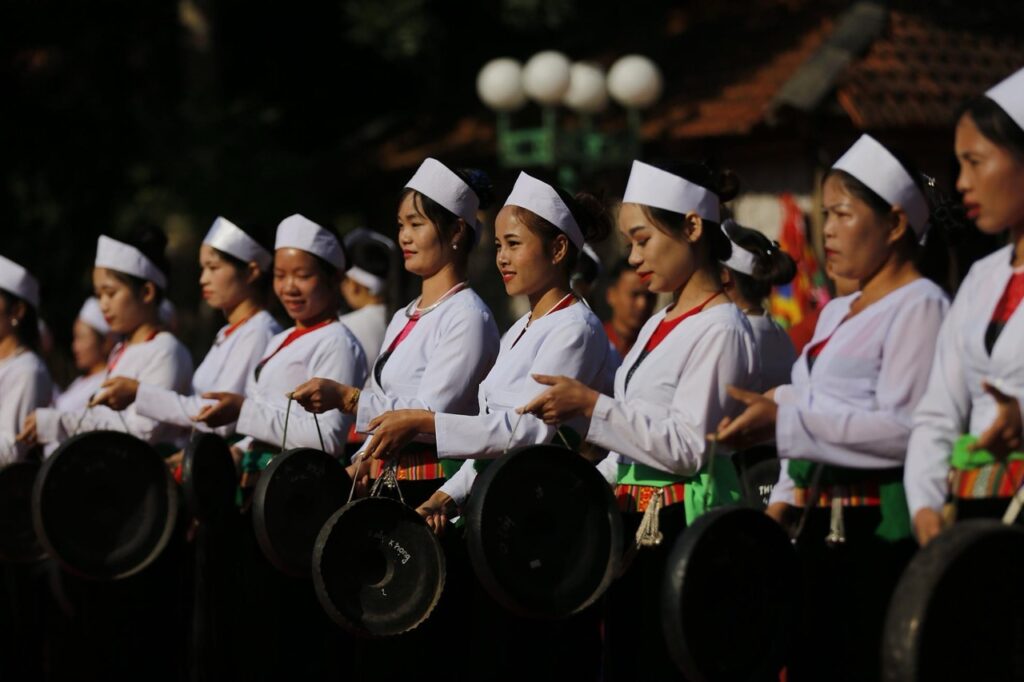 The park isn’t just about nature, it’s a cultural treasure too. Indeed, home to the Muong and Thai ethnic groups, Cuc Phuong offers a glimpse into the traditional lifestyles and customs that have been preserved for generations. Moreover, these communities live harmoniously with nature, practising sustainable agriculture and maintaining their cultural heritage.
The park isn’t just about nature, it’s a cultural treasure too. Indeed, home to the Muong and Thai ethnic groups, Cuc Phuong offers a glimpse into the traditional lifestyles and customs that have been preserved for generations. Moreover, these communities live harmoniously with nature, practising sustainable agriculture and maintaining their cultural heritage.
 Cuc Phuong boasts an incredible diversity of plant life, with over 2,000 plant species. For example, giant ancient trees, some over 1,000 years old, create a dense canopy, while a variety of ferns, orchids, and medicinal plants add to the park’s botanical richness. The forest is a vibrant tapestry of greenery, with seasonal blooms adding splashes of color throughout the year. For instance, the rare and endangered Chukrasia tabularis and Terminalia myriocarpa are found here, underscoring the park’s botanical significance.
Cuc Phuong boasts an incredible diversity of plant life, with over 2,000 plant species. For example, giant ancient trees, some over 1,000 years old, create a dense canopy, while a variety of ferns, orchids, and medicinal plants add to the park’s botanical richness. The forest is a vibrant tapestry of greenery, with seasonal blooms adding splashes of color throughout the year. For instance, the rare and endangered Chukrasia tabularis and Terminalia myriocarpa are found here, underscoring the park’s botanical significance.
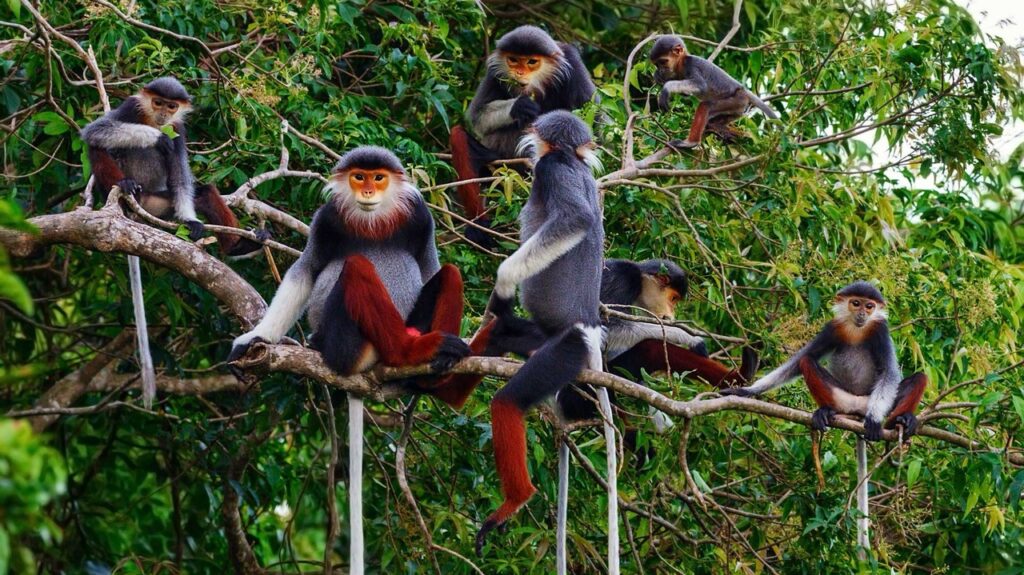 Similarly, the fauna here is just as impressive as the flora. The park is home to a myriad of animal species. In other words, the diversity includes mammals, birds, reptiles, and amphibians. Each contributes to the park’s complex ecosystem and makes it a hotspot for wildlife enthusiasts.
Similarly, the fauna here is just as impressive as the flora. The park is home to a myriad of animal species. In other words, the diversity includes mammals, birds, reptiles, and amphibians. Each contributes to the park’s complex ecosystem and makes it a hotspot for wildlife enthusiasts.
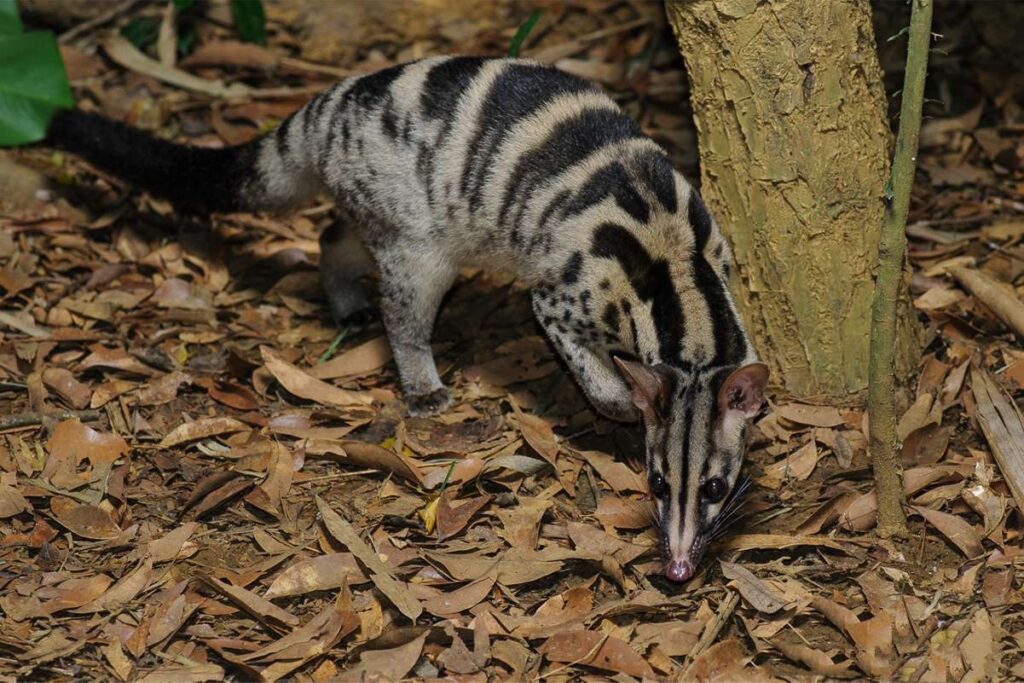 With 133 mammal species, including the endangered Delacour’s langur and the clouded leopard, Cuc Phuong is a mammal-watcher’s dream. Moreover, other notable mammals include the Asian black bear, the Asiatic brush-tailed porcupine, and the northern pig-tailed macaque. In addition, night safaris offer a chance to see nocturnal animals like civets and lorises.
With 133 mammal species, including the endangered Delacour’s langur and the clouded leopard, Cuc Phuong is a mammal-watcher’s dream. Moreover, other notable mammals include the Asian black bear, the Asiatic brush-tailed porcupine, and the northern pig-tailed macaque. In addition, night safaris offer a chance to see nocturnal animals like civets and lorises.
 Bird lovers, rejoice! The park is a haven for over 300 bird species. From the rare silver pheasant to the colorful racket-tailed treepie, birdwatching here is an unforgettable experience. The diversity includes the crested serpent eagle, the bar-bellied pitta, and the endangered red-collared woodpecker. Birdwatching tours, often led by experienced guides, can help visitors spot these avian treasures.
Bird lovers, rejoice! The park is a haven for over 300 bird species. From the rare silver pheasant to the colorful racket-tailed treepie, birdwatching here is an unforgettable experience. The diversity includes the crested serpent eagle, the bar-bellied pitta, and the endangered red-collared woodpecker. Birdwatching tours, often led by experienced guides, can help visitors spot these avian treasures.
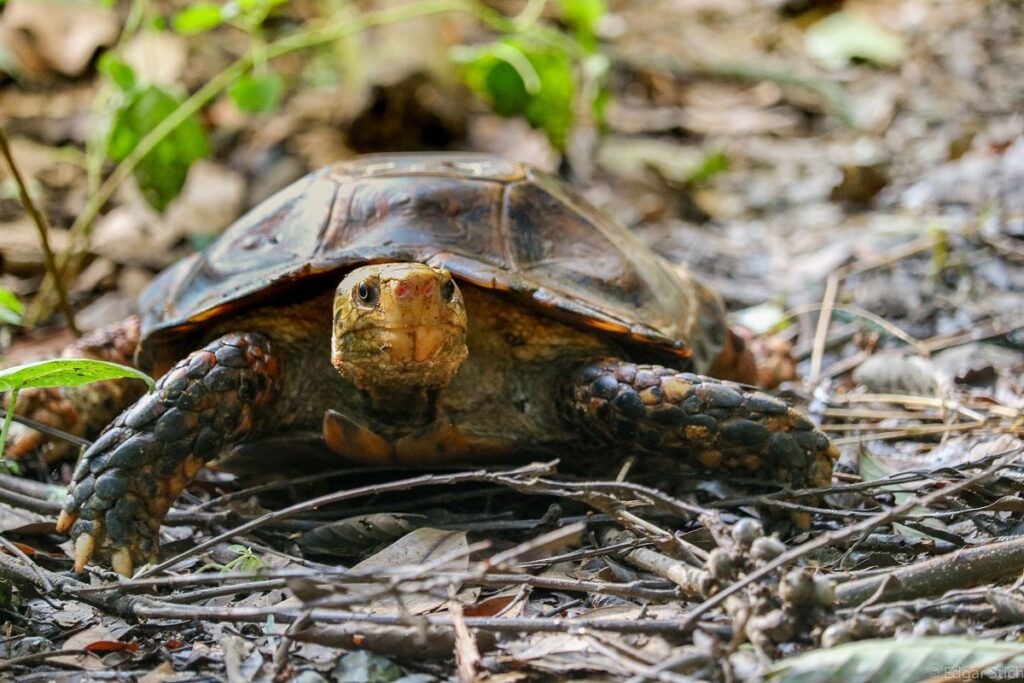 Cuc Phuong’s 122 species of reptiles and amphibians, such as the Vietnamese salamander and king cobra, highlight the park’s rich herpetofauna. The park also houses several turtle species, including the critically endangered Annam leaf turtle. These creatures thrive in the park’s diverse habitats, from dense forests to freshwater streams.
Cuc Phuong’s 122 species of reptiles and amphibians, such as the Vietnamese salamander and king cobra, highlight the park’s rich herpetofauna. The park also houses several turtle species, including the critically endangered Annam leaf turtle. These creatures thrive in the park’s diverse habitats, from dense forests to freshwater streams.
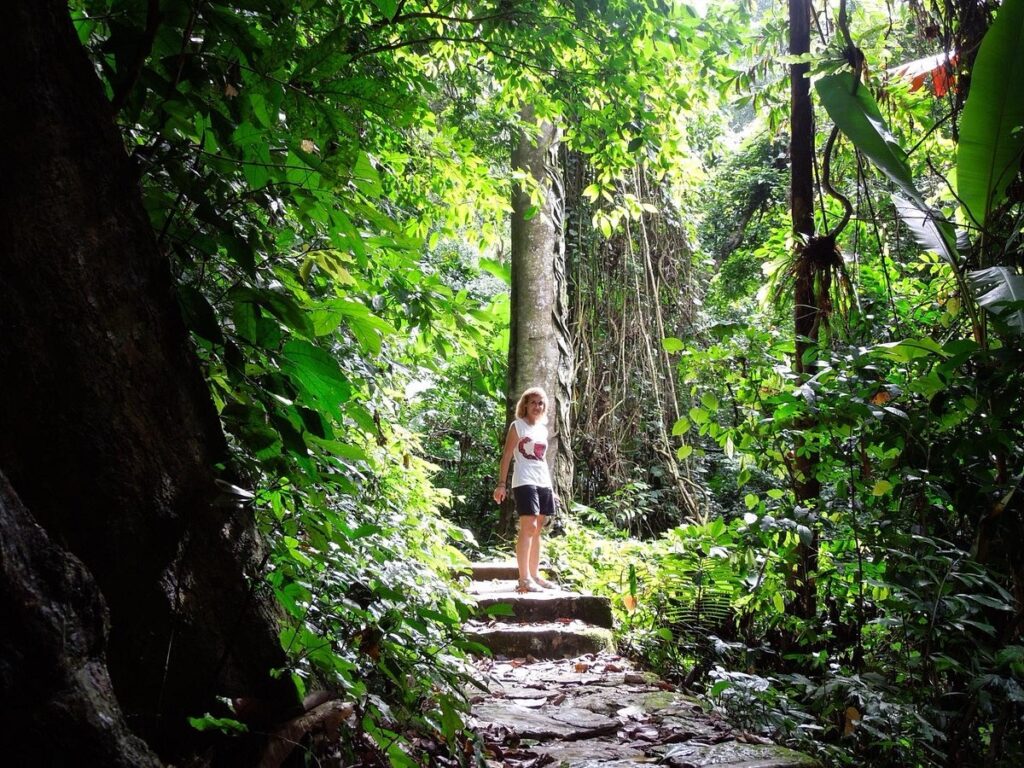 The park offers several trekking and hiking trails that cater to all fitness levels. Trails like the Ancient Tree Trail and the Prehistoric Man Cave Trail let you explore the park’s diverse landscapes. The challenging 16km-loop to Silver Cloud Peak rewards hikers with panoramic views of the surrounding mountains and valleys.
The park offers several trekking and hiking trails that cater to all fitness levels. Trails like the Ancient Tree Trail and the Prehistoric Man Cave Trail let you explore the park’s diverse landscapes. The challenging 16km-loop to Silver Cloud Peak rewards hikers with panoramic views of the surrounding mountains and valleys.
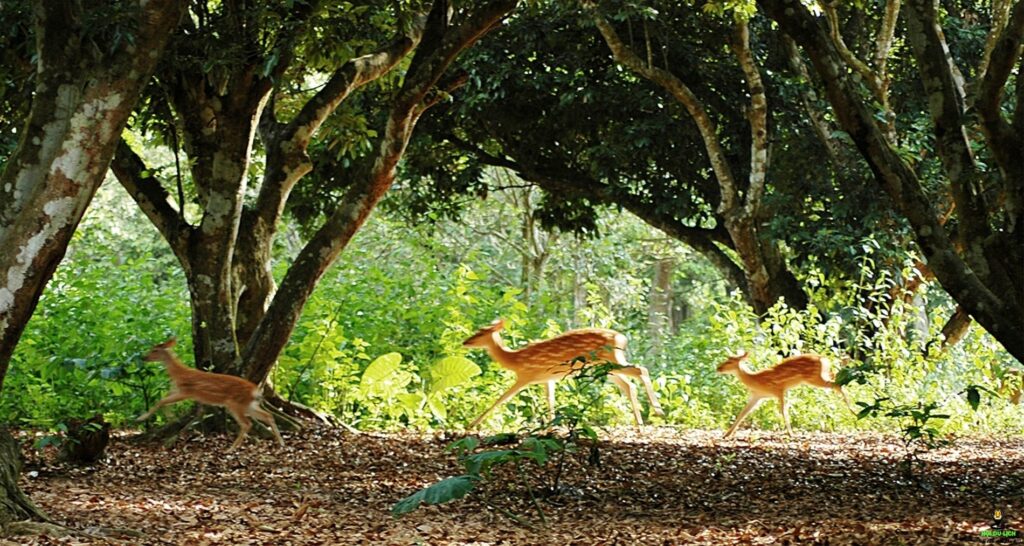 With patience and a bit of luck, you can spot some of the park’s elusive wildlife. Guided tours increase your chances of seeing rare species in their natural habitats. Rangers and local guides, with their extensive knowledge, can lead you to the best spots for sightings.
With patience and a bit of luck, you can spot some of the park’s elusive wildlife. Guided tours increase your chances of seeing rare species in their natural habitats. Rangers and local guides, with their extensive knowledge, can lead you to the best spots for sightings.
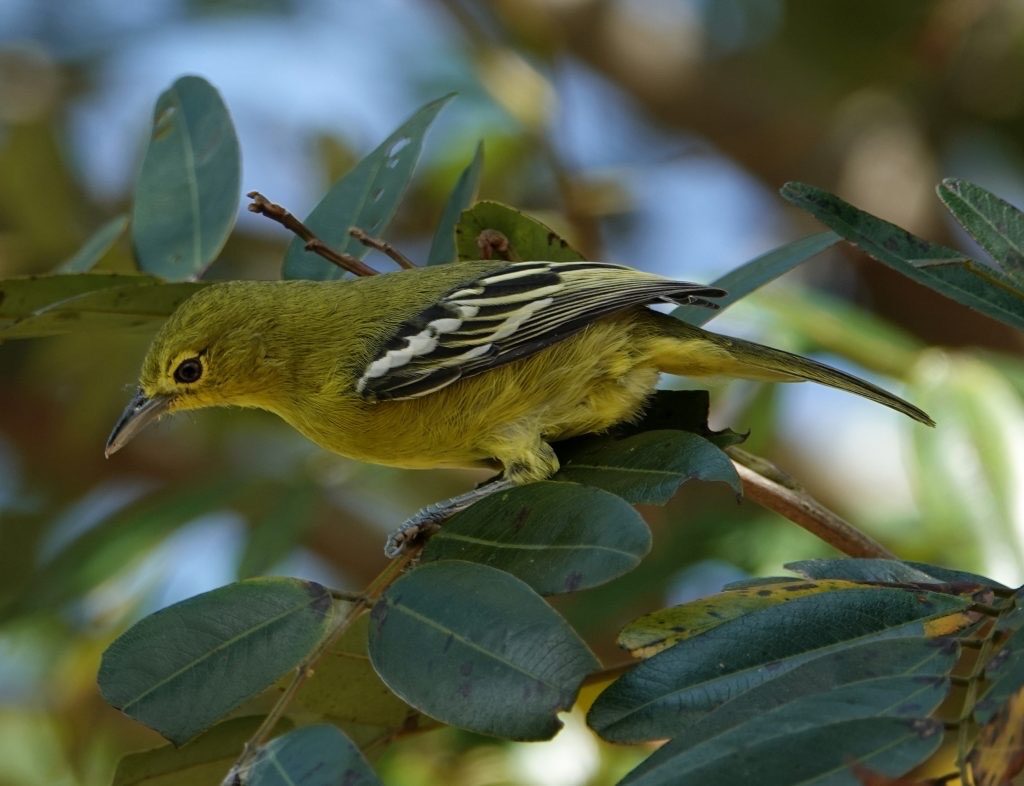 Birdwatching tours are particularly popular. Equipped with a pair of binoculars, you can catch sight of numerous rare and exotic birds flitting through the trees. The park’s varied habitats, from wetlands to forests, provide ideal conditions for birdwatching throughout the year.
Birdwatching tours are particularly popular. Equipped with a pair of binoculars, you can catch sight of numerous rare and exotic birds flitting through the trees. The park’s varied habitats, from wetlands to forests, provide ideal conditions for birdwatching throughout the year.
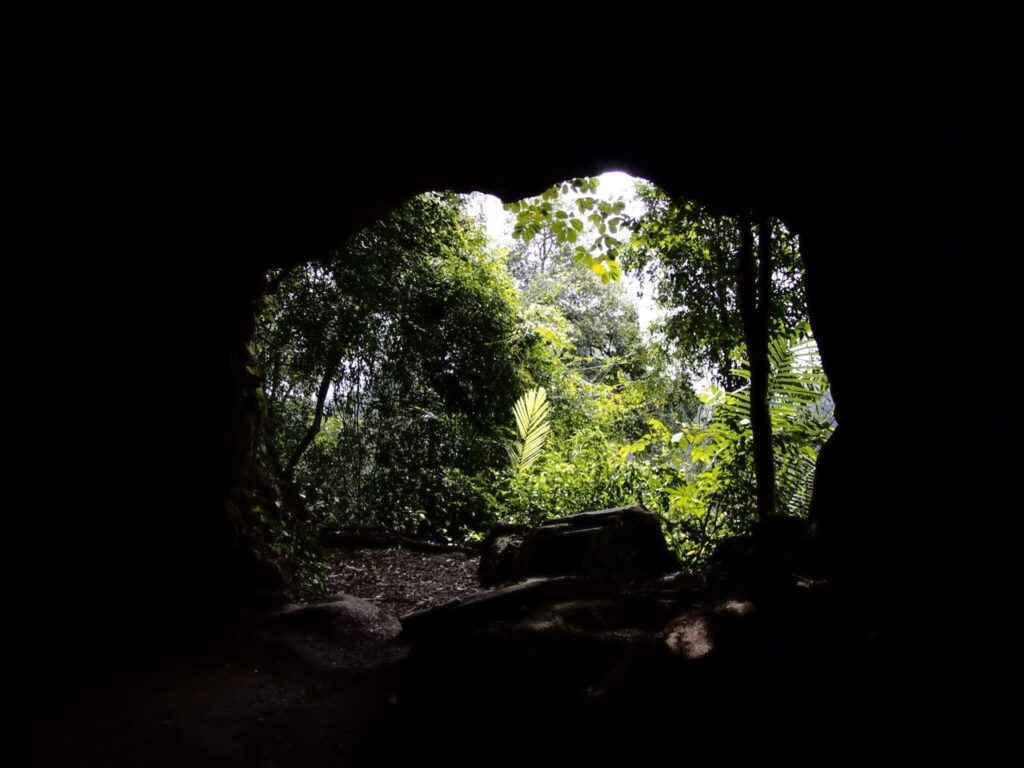 Cuc Phuong is home to several fascinating caves, such as the Cave of Prehistoric Man and the Son Cung Cave. These caves offer a peek into the park’s geological history and ancient human habitation. The Cave of Prehistoric Man, in particular, is significant for its archeological finds, including ancient tools and human remains dating back thousands of years.
Cuc Phuong is home to several fascinating caves, such as the Cave of Prehistoric Man and the Son Cung Cave. These caves offer a peek into the park’s geological history and ancient human habitation. The Cave of Prehistoric Man, in particular, is significant for its archeological finds, including ancient tools and human remains dating back thousands of years.
